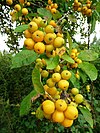Malus prunifolia
| Malus prunifolia | |
|---|---|

| |
| Malus prunifolia[1] | |
| Scientific classification | |
| Kingdom: | Plantae |
| Clade: | Tracheophytes |
| Clade: | Angiosperms |
| Clade: | Eudicots |
| Clade: | Rosids |
| Order: | Rosales |
| Family: | Rosaceae |
| Genus: | Malus |
| Species: | M. prunifolia
|
| Binomial name | |
| Malus prunifolia | |
Malus prunifolia is a species of
crabapple tree known by the common names plumleaf crab apple,[4] plum-leaved apple,[5] pear-leaf crabapple, Chinese apple and Chinese crabapple.[6] It is native to China, and is grown elsewhere for use as an ornamental tree or as rootstock. It reaches from between 3 and 8 meters tall and bears white flowers and yellow or red fruit.[3]
It was described botanically by
Pyrus, and transferred to Malus in 1803 to produce the nomenclatural treatment used here.[7]
Range and habitat
Malus prunifolia is found in China in the provinces of
Nei Mongol, Qinghai, Shaanxi, Shandong, Shanxi, and possibly Xinjiang. It is adapted to grow at a variety elevations from sea-level plains, to slopes as high as 1300 meters.[3]
Varieties
Malus prunifolia has at least four varieties, some are grown for their fruit:[6][8][9]
- Malus prunifolia var. obliquipedicellata X.W. Li & J.W. Sun
M. prunifolia var. prunifolia
M. prunifolia var. ringo Asami (Chinese apple)
M. prunifolia var. rinki (Koidz.) Rehder P.L.Wilson (plum-leaf or Chinese crabapple)
References
- ^ Cirrus Digital Plum-leaved Crabapple
- . Retrieved 19 November 2021.
- ^ Flora of China. eFloras. p. 184. Retrieved September 11, 2009.
- ^ USDA, NRCS (n.d.). "Malus prunifolia". The PLANTS Database (plants.usda.gov). Greensboro, North Carolina: National Plant Data Team. Retrieved 27 January 2016.
- ^ BSBI List 2007 (xls). Botanical Society of Britain and Ireland. Archived from the original (xls) on 2015-06-26. Retrieved 2014-10-17.
- ^ a b "Search results for: Malus". Archived from the original on April 4, 2010. Retrieved September 11, 2009.
- ^ [1] The International Plant Names Index
- St. Louis, Missouri: Missouri Botanical Garden. Retrieved September 11, 2009.
- ^ Michel H. Porcher (May 10, 2005). "Sorting Malus names". Multilingual Multiscript Plant Name Database. University of Melbourne. Retrieved September 11, 2009.


